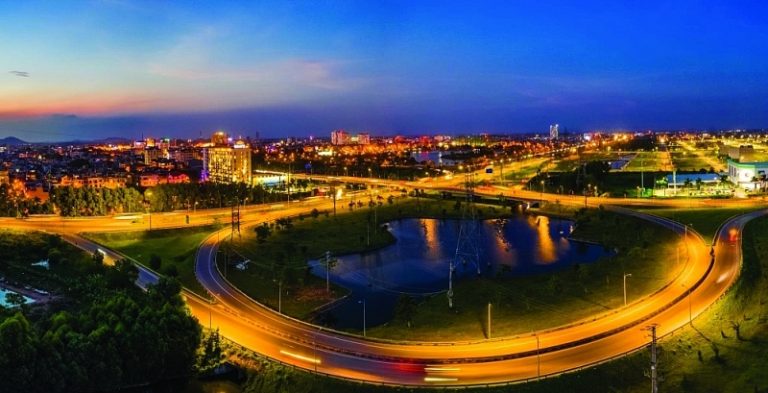In the final days of 2025, the construction atmosphere at national key transportation projects in Bac Ninh Province remains vibrant and bustling. These projects play an essential role in realizing the Resolution of the 13th National Party Congress, helping Bac Ninh soon become a powerful economic growth engine in the northern region.

The roar of machinery and the dedication of thousands of officers and workers have created a dynamic picture of a locality making remarkable breakthroughs. Major projects such as Gia Binh International Airport, the connecting road between Gia Binh Airport and Hanoi Capital, Ring Road No.4 of the Capital Region, and the Cam Ly railway bridge on the Kep–Ha Long line are massive construction sites with no break, driven by strong political determination and broad public consensus.
Under the close leadership of the Bac Ninh Provincial Party Committee, key transportation projects have achieved impressive results. Nguyen Hong Thai, Secretary of the Bac Ninh Provincial Party Committee, emphasized: “The Gia Binh International Airport project is a modern national key project of international scale. It will not only serve as an aviation gateway for Hanoi and the northern region but also become a major regional transit hub, playing a crucial role in regional connectivity and integration. Therefore, local authorities must continue effective communication and mobilization efforts to ensure public consensus, helping people understand the long-term benefits for current and future generations.”
Located just 40km from the center of Hanoi, Gia Binh International Airport is gradually taking shape across the communes of Gia Binh, Luong Tai, Nhan Thang, and Lam Thao. This national key project is being developed to meet 4E standards, with the vision of becoming a next-generation smart airport serving both civilian and defense purposes. According to the Government’s report submitted to the National Assembly Standing Committee on November 6, 2025, the project has a total investment of approximately VND 196,378 billion. In the first phase, by 2030, it will accommodate 30 million passengers and 1.6 million tons of cargo annually, later expanding to 50 million passengers and 2.5 million tons of cargo.
To kick-start the project, Bac Ninh Province launched an emulation movement: “80 peak days and nights for site clearance, 256 days and nights to complete projects related to Gia Binh International Airport, and 468 days and nights to complete the connecting road between Gia Binh Airport and Hanoi Capital through the provincial section.” To date, temporary compensation for agricultural land has exceeded 436 hectares (excluding 125 hectares from phase 1), with nearly VND 1,900 billion paid to over 4,000 households.
Luong Trung Hau, Chairman of the Gia Binh Commune People’s Committee, shared: “We listen to the people’s concerns and explain every question thoroughly to build consensus. The most important lesson is ensuring unity within the political system and maintaining the pioneering role of Party members.”
Despite difficulties such as scarce construction materials and a large clearance area (over 1,884 hectares affecting 7,100 households), the Provincial Steering Committee has established an inter-agency task force to promptly resolve issues. Vuong Quoc Tuan (then Chairman of the Provincial People’s Committee) affirmed: “Site clearance is the most important political task. The province must prioritize land compensation and ensure smooth resettlement because the Gia Binh Airport project not only drives economic growth — especially in logistics and high-tech industry — but also carries profound social significance, demonstrating the Party and State’s care for the people.”
Along with the airport, the connecting road to Hanoi — 27.7km long through Bac Ninh Province with a total investment of over VND 47,600 billion — will feature 10 main lanes, four auxiliary lanes, and a speed limit of 120 km/h. The route passes through eight communes and wards, covering 607 hectares and affecting 1,169 households. It is expected to boost transportation infrastructure, expand urban space, and create seamless connectivity with Ring Roads No.3 and No.4, thereby driving development in the Northern Key Economic Region.
Currently, construction progress is being accelerated. The Provincial People’s Committee has issued detailed plans and assigned specific responsibilities to each functional unit. The process begins with appraising the feasibility study report, to be completed before December 31, 2026, while site clearance will proceed in parallel.
In Thuan Thanh Ward, the site clearance for a 20-hectare resettlement area is being carried out urgently, with measurement, surveying, and public disclosure of land areas already completed. Nguyen Cong Hoan, a resident, shared: “My family proactively declared 1,200 square meters of agricultural land because road development benefits the community. Many households in our village will be resettled with modern infrastructure, improving quality of life.”
Challenges such as adjusting planning boundaries and determining land origins have been addressed through direct dialogues between provincial leaders and local residents.
For the 35.3km-long section of Ring Road No.4 passing through Bac Ninh, with an investment of over VND 5,200 billion, site clearance has reached 99.98%, and construction value has now reached more than 40%.
Tran Trong Toan, representative of contractor package No.14, stated: “We are mobilizing all manpower and equipment, working day and night to meet the technical completion schedule.” Once completed, the project will help ease traffic congestion, open new development spaces, and enhance Bac Ninh’s connectivity to strategic economic corridors.
In parallel with Ring Road No.4 is the Lao Cai–Hanoi–Hai Phong railway project. The section passing through Bac Ninh is 3.76km long, occupies 40.54 hectares of land, and requires more than VND 1,085 billion in compensation. Site clearance is being urgently carried out with the goal of basic completion before December 31, 2025. Obstacles at key transportation projects have consistently received attention from the National Steering Committee, which has proposed multiple solutions to ensure timely project completion.
In addition to national key transportation projects, Bac Ninh is also accelerating other transportation initiatives such as the construction of the 3,267m-long Cam Ly Bridge (nearly VND 800 billion investment) connecting to Hai Phong, the expansion of Nhu Nguyet Bridge, and the Ha Bac 1–2 Bridges. In the near future, these projects will help Bac Ninh complete its inter-regional transportation network, providing a strong foundation for socio-economic development and advancing its goal of becoming a centrally governed city before 2030.
Source: nhandan.vn





